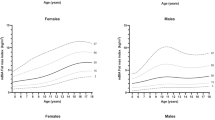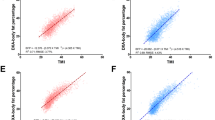Abstract
Objectives: To compare the relationship between body mass index (BMI) and body fat percentage (BF%) in children of different ethnic background.
Design: Cross-sectional observational study.
Setting: The study was performed in three different locations, Singapore, Beijing and Wageningen (The Netherlands).
Subjects: In each centre 25 boys and 25 girls, aged 7–12 y, were selected. They were matched on age, sex and body height.
Methods: Body weight and body height was measured following standardized procedures. The body mass index (BMI) was calculated as weight/height squared (kg/m2). Body fat was measured by densitometry in Beijing and Wageningen and by dual energy X-ray absorptiometry (DXA) in Singapore. The DXA measurements in Singapore were validated against densitometry.
Results: There were no significant differences in BF% or BMI within each gender group across the three study sites. However, after controlling for (non-significant) differences in age and BF%, the Singapore children had a lower (mean±s.e.) BMI (15.6±0.3) than the Beijing 17.6±0.3) and Wageningen (16.9±0.3) children. For the same BMI, age and sex the Singapore children had a significant higher BF% (24.6±0.7) than the Beijing (19.2±0.8) and Wageningen (20.3±0.7) children.
Conclusions: The study strongly suggests that the relationship between BF% and BMI (or weight and height) is different among children of different ethnic background. Consequently growth charts and BMI cut-off points for underweight, overweight and obesity in children may have to be ethnic-specific.
This is a preview of subscription content, access via your institution
Access options
Subscribe to this journal
Receive 12 print issues and online access
$259.00 per year
only $21.58 per issue
Buy this article
- Purchase on Springer Link
- Instant access to full article PDF
Prices may be subject to local taxes which are calculated during checkout

Similar content being viewed by others
References
Bland, JM & Altman, DG (1986). Statistical methods for assessing agreement between two methods of clinical measurements. Lancet, i, 307–310.
Cole, TJ, Bellizzi, MC, Flegal, KM & Dietz, WH (2000). Establishing a standard definition for child overweight and obesity worldwide: International survey. Br. Med. J., 320, 1240–1243.
Demerath, EW, Guo, SS, Chumlea, WC, Towne, B, Roche, AF & Siervogel, RM (2002). Comparison of percent body fat estimates using air displacement plethysmography and hydrodensitometry in adults and children. Int. J. Obes. Relat. Metab. Disord., 26, 389–397.
Deurenberg, P (2001). Universal cut-off BMI points for obesity are not appropriate. Br. J. Nutr., 85, 135–136.
Deurenberg, P, Pieters, JJL & Hautvast, JGAJ (1990). The assessment of the body fat percentage by skinfold thickness measurements in childhood and young adolescence. Br. J. Nutr., 63, 293–303.
Deurenberg, P, Weststrate, JA & Seidell, JC (1991). Body mass index as a measure of body fatness: age and sex specific prediction formulas. Br. J. Nutr., 65, 105–114.
Deurenberg, P, Ge, K, Hautvast, JGAJ & Wang, J (1997). Body mass index as predictor for body fat: comparison between Chinese and Dutch adult subjects. Asia Pacific J. Clin. Nutr., 6, 102–105.
Deurenberg, P, Yap, M & Van Staveren, WA (1998). Body mass index and percent body fat: a meta analysis among different ethnic groups. Int. J. Obes. Relat. Metab. Disord., 22, 1164–1171.
Deurenberg, P, Deurenberg-Yap, M, Wang, J, Lin Fu, Po & Schmidt, G (1999). The impact of body build on the relationship between body mass index and body fat percent. Int. J. Obes. Relat. Meab. Disord., 23, 537–542.
Deurenberg-Yap, M, Schmidt, G, Staveren, WA & Deurenberg, P (2000). The paradox of low body mass index and high body fat percent among Chinese, Malays and Indians in Singapore. Int. J. Obes. Relat. Metab. Disord., 24, 1011–1017.
Deurenberg-Yap, M, Chew, SK, Lin, V, Tan, BY, van Staveren, WA & Deurenberg, P (2001). Relationships between indices of obesity and its co-morbidities among Chinese, Malays and Indians in Singapore. Int. J. Obes. Relat. Metab. Disord., 25, 1554–1562.
Ellis, KJ (1997a). Body composition of a young multi-ethnic male population. Am. J. Clin. Nutr., 66, 1323–1331.
Ellis, KJ, Abrams, SA & Wong, WW (1997a). Body composition of a young multi-ethnic female population. Am. J. Clin. Nutr., 65, 724–731.
Forbes, GB (1987). Human Body Composition, New York: Springer Verlag
Gallagher, D, Heymsfield, SB, Heo, M, Jebb, SA, Murgatroyd, PR & Sakamoto, Y (2000). Healthy percentage body fat ranges: an approach for developing guidelines based on body mass index. Am. J. Clin. Nutr., 72, 694–701.
Guricci, S, Hartriyanti, Y, Hautvast, JGAJ & Deurenberg, P (1998). Relationship between body fat and body mass index: differences between Indonesians and Dutch Caucasians. Eur. J. Clin. Nutr., 52, 779–783.
He, M, Tan, KCB, Li, ETS & Kung, AWC (2001). Body fat determination by dual energy X-ray absorptiometry and its relation to body mass index and waist circumference in Hong Kong Chinese. Int. J. Obes. Relat. Metab. Disord., 25, 748–752.
Jebb, SA & Elia, M (1993). Techniques for the measurement of body composition: a practical guide. Int. J. Obes., 17, 611–621.
Kleinbaum, DG, Kupper, LL, Muller, KE & Nizam, A (1998). Applied Regression Analysis and Other Multivariate Methods, 3rd edn Pacific Grove: Duxbury Press
Ko, GTC, Chan, JC, Cockram, CS & Woo, J (1999). Prediction of hypertension, diabetes, dyslipidaemia or albuminuria using simple anthropometric indexes in Hong Kong Chinese. Int. J. Obes. Relat. Metab. Disord., 23, 1136–1142.
Ko, GTC, Tang, J, Chan, JCN, Wu, MMF, Wai, HPS & Chen, R (2001). Lower BMI cut-off value to define obesity in Hong Kong Chinese: an analysis based on body fat assessment by bioelectrical impedance. Br. J. Nutr., 85, 239–242.
Nuñez, C, Kovera, AJ, Pietrobelli, A, Heshka, S, Horlich, M, Kehayais, JJ, Wang, ZM & Heysmfield, SB (1999). Body composition in children and adults by air displacement plethysmography. Eur. J. Clin. Nutr., 53, 382–387.
Rolland-Cachera, MF, Deheeger, M, Avon, P, Guilloud-Bataille, M, Patois, E & Sempe, M (1987). Tracking adiposity patterns from 1 month to adulthood. Ann. Hum. Biol., 14, 219–222.
Steering Committee (2000). The Asia perspective: redefining obesity and its treatment, Melbourne: International Diabetes Institute
Wang, J & Deurenberg, P (1996). The validity of predicted body composition in Chinese adults from anthropometry and bio-electrical impedance in comparison with densitometry. Br. J. Nutr., 76, 175–182.
Wang, J, Thornton, JC, Russell, M, Burastero, S, Heymsfield, SB & Pierson, RN (1994). Asians have lower BMI (BMI) but higher percent body fat than do Whites: comparisons of anthropometric measurements. Am. J. Clin. Nutr., 60, 23–28.
WHO (1986). Use and interpretation of anthropometric indicators of nutritional status. Bull. WHO, 64, 929–941.
WHO (1998). Obesity: preventing and managing the global epidemic, Report on a WHO Consultation on Obesity, Geneva, 3–5 June, 1997, WHO/NUT/NCD/98.1 Geneva: WHO
Acknowledgements
Nestlé Foundation sponsored the body composition studies in Beijing. The body composition measurements in Wageningen were part of various projects on children, carried out at the Wageningen University. The authors are grateful to the children who participated in the studies.
Author information
Authors and Affiliations
Contributions
Guarantor: P Deurenberg.
Contributors: Data were collected by PD, GS and JW. PD and MD-Y conducted the statistical analyses and wrote the draft paper. All authors contributed to the final version.
Corresponding author
Rights and permissions
About this article
Cite this article
Deurenberg, P., Deurenberg-Yap, M., Foo, L. et al. Differences in body composition between Singapore Chinese, Beijing Chinese and Dutch children. Eur J Clin Nutr 57, 405–409 (2003). https://doi.org/10.1038/sj.ejcn.1601569
Received:
Revised:
Accepted:
Published:
Issue Date:
DOI: https://doi.org/10.1038/sj.ejcn.1601569
Keywords
This article is cited by
-
Anthropometric Database of the Preschool Children from 2 to 6 Years in Taiwan
Journal of Medical and Biological Engineering (2019)
-
Pediatric adiposity stabilized in Switzerland between 1999 and 2012
European Journal of Nutrition (2014)
-
Percentage body fat in apparently healthy school children from northern India
Indian Pediatrics (2013)
-
Ethnic and sex differences in body fat and visceral and subcutaneous adiposity in children and adolescents
International Journal of Obesity (2012)
-
Adiposity Is Not Equal in a Multi‐Race/Ethnic Adolescent Population: NHANES 1999–2004
Obesity (2011)



